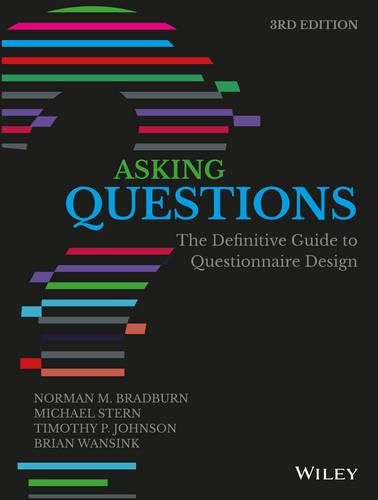Readings Newsletter
Become a Readings Member to make your shopping experience even easier.
Sign in or sign up for free!
You’re not far away from qualifying for FREE standard shipping within Australia
You’ve qualified for FREE standard shipping within Australia
The cart is loading…






Asking Questions serves as a practical, introductory guide to questionnaire design. This classic book, first published more than 35 years ago, has been an essential tool for students and professionals on how to ask the right questions.
The overall format and structure of the third edition will follow previous editions; however, significant updates and improvements will made throughout, making this the new edition up-to-date on the latest survey trends and more classroom friendly. Included are new chapters on 1) web surveys and multimode surveys and 2) polls and polling. There will also be new or expanded coverage on important survey design issues, such as integrating mode choice and sequencing of modes, cognitive models of response including satisficing, additional examples of questionnaires for different situations and contexts, new guidance on effective testing of survey items and how to ask demographic questions, and dis greater discussion and detail on using basic scalar questions. All illustrative examples, including most figures, will be updated. Student-friendly pedagogy, such as learning objectives, summary, key terms, and review questions, and web-based resources, such lecture slides and a test bank, will all be new to the third edition.
$9.00 standard shipping within Australia
FREE standard shipping within Australia for orders over $100.00
Express & International shipping calculated at checkout
Stock availability can be subject to change without notice. We recommend calling the shop or contacting our online team to check availability of low stock items. Please see our Shopping Online page for more details.
Asking Questions serves as a practical, introductory guide to questionnaire design. This classic book, first published more than 35 years ago, has been an essential tool for students and professionals on how to ask the right questions.
The overall format and structure of the third edition will follow previous editions; however, significant updates and improvements will made throughout, making this the new edition up-to-date on the latest survey trends and more classroom friendly. Included are new chapters on 1) web surveys and multimode surveys and 2) polls and polling. There will also be new or expanded coverage on important survey design issues, such as integrating mode choice and sequencing of modes, cognitive models of response including satisficing, additional examples of questionnaires for different situations and contexts, new guidance on effective testing of survey items and how to ask demographic questions, and dis greater discussion and detail on using basic scalar questions. All illustrative examples, including most figures, will be updated. Student-friendly pedagogy, such as learning objectives, summary, key terms, and review questions, and web-based resources, such lecture slides and a test bank, will all be new to the third edition.